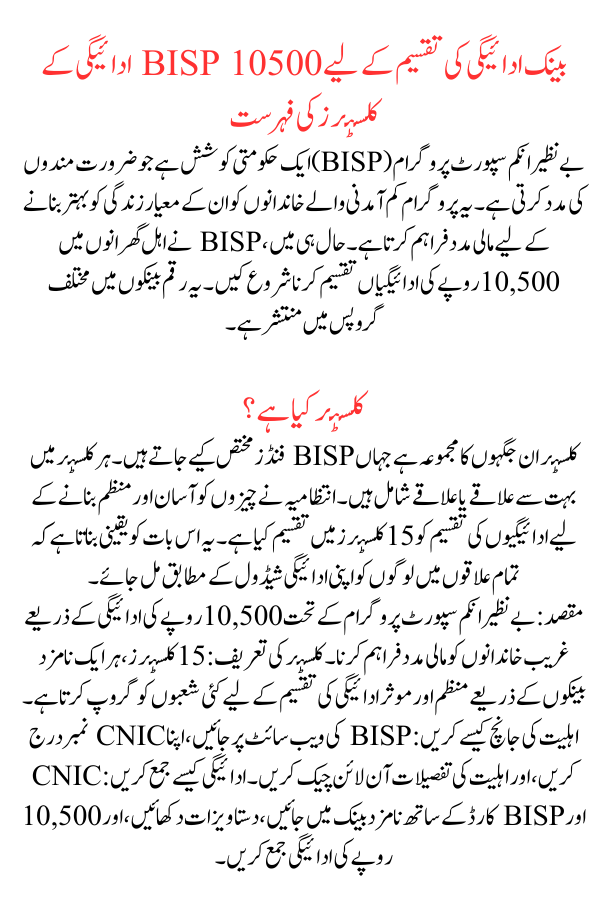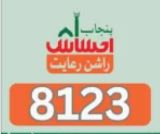
List of BISP 10500 Payment Clusters for Bank Payment Distribution
The Benazir Income Support Program (BISP) is a government effort that assists those in need. The program provides financial assistance to low-income families to improve their standard of living. Recently, the BISP began distributing payments of 10,500 rupees to qualifying households. This money is dispersed across banks in various groups.
What is a Cluster?
A cluster is a collection of places in which BISP funds are allocated. Each cluster includes many areas or localities. The administration has divided payment distribution into 15 clusters to make things easier and more orderly. This ensures that people in all areas receive their payments on schedule.
Purpose: Provide financial support to poor families through payment of 10,500 rupees under the Benazir Income Support Program. Cluster Definition: 15 clusters, each grouping several areas for organized and efficient payment distribution through designated banks. How to Check Eligibility: Visit the BISP website, enter your CNIC number, and check eligibility details online. How to Collect Payment: Go to the designated bank with CNIC and BISP card, show documents, and collect payment of 10,500 rupees.

List of 15 Clusters
Payments will be distributed through a new banking system. Below is a list of 15 clusters with their respective banks and districts:
Cluster 1: Habib Bank Limited (Punjab Districts)
Districts: Rawalpindi, Murree, Attock, Chakwal, Talagang, Jhelum, Islamabad, Mandi Bahauddin, Narowal, Sialkot, Gujrat, Sargodha, Bhakkar, Khushab
Cluster 2: Bank Alfalah Limited (AJK, GB, KP, and Mixed Punjab Districts)
Districts: Muzaffarabad, Hattian, Jhelum Valley, Neelum, Mirpur, Kotli, Bhimber, Gilgit, Hunza, Nagar, Astore, Shigar, Skardu, Rondu, Abbottabad, Mansehra, Lower Chitral, Upper Chitral, Swat, Battagram, Torghar, Lower Dir, Upper Dir, Haripur, Lower Kohistan, Upper Kohistan, Kolai Palas Kohistan, Sahiwal
Cluster 3: Bank Alfalah Limited (KP Districts)
Districts: Peshawar, Charsadda, Mohmand Agency, Khyber Agency, North Waziristan, Lower South Waziristan, Upper South Waziristan, Kurram Agency, Orakzai Agency, Nowshera, Hangu, Swabi, Bajaur
Cluster 4: Mobilink Microfinance Bank Limited (Sindh Districts)
Districts: Sanghar, Nawabshah/Benazirabad, Mirpur Khas, Tharparkar, Matiari, Umerkot
Cluster 5: Habib Bank Limited (Mixed Districts)
Districts: Karachi Central, Karachi East, Korangi, Malir, Karachi South, Karachi West, Kemari, Thatta, Awaran, Toba Tek Singh, Mianwali, Multan, Pakpattan, Faisalabad, Gwadar
Cluster 6: Bank of Punjab (Mixed Districts)
Districts: Jamshoro, Dadu, Qilla Saifullah, Qilla Abdullah, Chaman, Pishin, Karezat, Tank, Lasbela, Hub, Rahim Yar Khan, Lodhran, Jhang
Cluster 7: Mobilink Microfinance Bank Limited (Mixed Districts)
Districts: Sujawal, Tando Allahyar, Tando Muhammad Khan, Hyderabad, Kharan, Mastung, Chagai, Nushki, Kachhi, Malakand
Cluster 8: Bank of Punjab (Mixed Districts)
Districts: Badin, Bannu, Kalat, Sibi, Surab, Rahim Yar Khan, Lodhran, Jhang
Cluster 9: Habib Bank Limited (Mixed Districts)
Districts: Khairpur, Harnai, Ziarat, Sibi, Lakki Marwat, Okara, Sheikhupura
Cluster 10: Bank of Punjab (Mixed Districts)
Districts: Jacobabad, Qambar Shahdadkot, Jhal Magsi, Naseerabad, Kohlu, Sohbatpur, Usta Muhammad, Khanewal, DG Khan, Taunsa, Chiniot
Cluster 11: Bank Alfalah Limited (Mixed Districts)
Districts: Kashmore, Lehri, Dera Bugti, Kohlu, Usta Muhammad, Khanewal, DG Khan, Taunsa, Chiniot
Cluster 12: Bank Alfalah Limited (Mixed Districts)
Districts: Larkana, Shikarpur, Barkhan, Loralai, Duki, Sherani, Buner, DI Khan, Haveli, Ghizer, Wazirabad, Layyah, Bahawalpur
Cluster 13: Habib Bank Limited (Mixed Districts)
Districts: Ghotki, Zhob, Musakhel, Kasur, Bahawalnagar, Gujranwala
Cluster 14: Telenor Microfinance Bank Limited (Mixed Districts)
Districts: Sukkur, Khuzdar, Washuk, Kohat, Kech/Turbat, Panjgur, Rajanpur, Poonch, Nankana Sahib, Vehari,
Ghanche, Diamer
Cluster 15: Habib Microfinance Bank Limited (Mixed Districts)
Districts: Naushahro Feroze, Shangla, Quetta, Muzaffargarh, Kot Addu, Jampur, Kharmang, Tangier
How to Check Eligibility
To see if you are eligible for the BISP payment, you need to follow these steps:
Visit the official BISP website.
Enter your CNIC (Computerized National Identity Card) number.
Click on the “Check Eligibility” button.
If you are eligible, you will see your details and payment status.
How to Collect Your Payment 2024
Once you are confirmed as eligible, you can collect your payment from the designated bank. Here are the steps to collect your payment:
Go to the bank mentioned in your eligibility details.
Take your CNIC and BISP cards with you.
Show your documents to the bank officer.
Collect your payment of 10,500 rupees.
Importance of the BISP Program
The BISP program is extremely crucial to many Pakistani households. It enables them to purchase food, pay for education, and meet other basic requirements. Money donated through this initiative has the potential to alter people’s lives by providing financial assistance to those in most need.
Challenges in Payment Distribution
Even though the BISP program is very helpful, there are some challenges in distributing the payments. Some people might face problems like:
Delays in payment due to technical issues.
Difficulty in reaching the bank, especially for those living in remote areas.
Problems with your CNIC or BISP card.
The government is working to solve these issues and make the payment process smoother for everyone.
Conclusion
The BISP 10500 payment distribution in 15 clusters is a big step toward assisting impoverished households throughout Pakistan. The government hopes to improve the efficiency of the distribution process by arranging it into clusters. To benefit from this program, eligible families should complete the requirements to verify their eligibility and collect their funds.
FAQs
What is the BISP payment amount? The BISP payment amount is 10,500 rupees.
How can I check my BISP eligibility? Visit the official BISP website and enter your CNIC number to check your eligibility.
Which banks are involved in BISP payment distribution? Several banks, including Habib Bank Limited, Bank Alfalah Limited, and Mobilink Microfinance Bank Limited, are involved.
How do I collect my BISP payment? Go to the designated bank with your CNIC and BISP card to collect your payment.
What are the challenges in BISP payment distribution? Common challenges include delays due to technical issues and difficulties reaching the bank.
Why is the BISP program important? It provides financial assistance to low-income families, helping them meet basic needs.
How are the BISP payments organized? Payments are organized into 15 clusters to ensure efficient distribution.
What should I do if I face issues with my BISP card?
